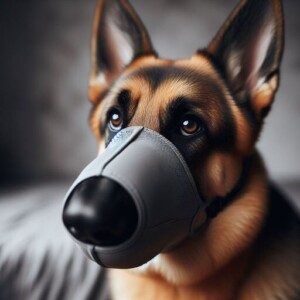
Muzzling a dog has received a really bad rap, and many people even believe that putting a muzzle on a dog is cruel or inhumane.
This perception was perhaps ignited by images of greyhounds being caged and muzzled with wire contraptions.
Myth #1: The muzzle interferes with the dog’s breathing.
My parents thought this because after they removed their German shepherd’s denim muzzle while in the car, he began panting. However, look at the design of a muzzle.
The animal’s nostrils are exposed. My parents thought that breathing was compromised because the design prevented barking, i.e., opening his mouth.
Eventually my mother asked a vet if these devices cut off breathing, and the vet assured her that they do no such thing.
Myth #2: Muzzles stress a dog out.
This same vet then added, “Muzzles relax dogs and make them feel secure.”
And I have witnessed this many times with their dog; he seems most relaxed when it’s on him, and he even falls asleep with it on.
Of course, at a buzzing vet clinic, the gadget doesn’t do much to calm the dog, but that’s because at the clinic, there is sensory overload; the animal could see, hear and smell all the dogs there, plus the cats, in the waiting room.
Myth # 3: Muzzles prevent a dog from drinking.
This depends on the design of the contraption.
A mesh design, also known as a basket design, will allow drinking, if the water is high enough in a bowl.
The dog simply proceeds to drink, and pushes down into the bowl, and the water level rises through the muzzle and the animal can lap up the water.
The other common design, in which the gadget is a solid material such as denim, will not permit drinking.
Myth # 4: A muzzle doesn’t guarantee protection from getting bitten.
Again, this depends on the design. The mesh or basket type will, indeed, prevent biting.
Myth # 5: A muzzle hurts.
They do not; make sure they are not strapped on too tightly, that’s all.
Myth # 6: A dog will associate a muzzle with punishment.
You will determine this, not the muzzle.
If right after you put the device on your dog, you yell at him, strike him, lock him in a room, or subject the animal to some other aversive condition, then yes, he will associate the device with punishment.
I put one on my parents’ dog before giving him medical injections — 30 minutes before, so that he wouldn’t associate the device with needles.
A treat at the bottom of the muzzle will make the dog associate this device with getting a treat — and that’s always a happy time for a dog!


























